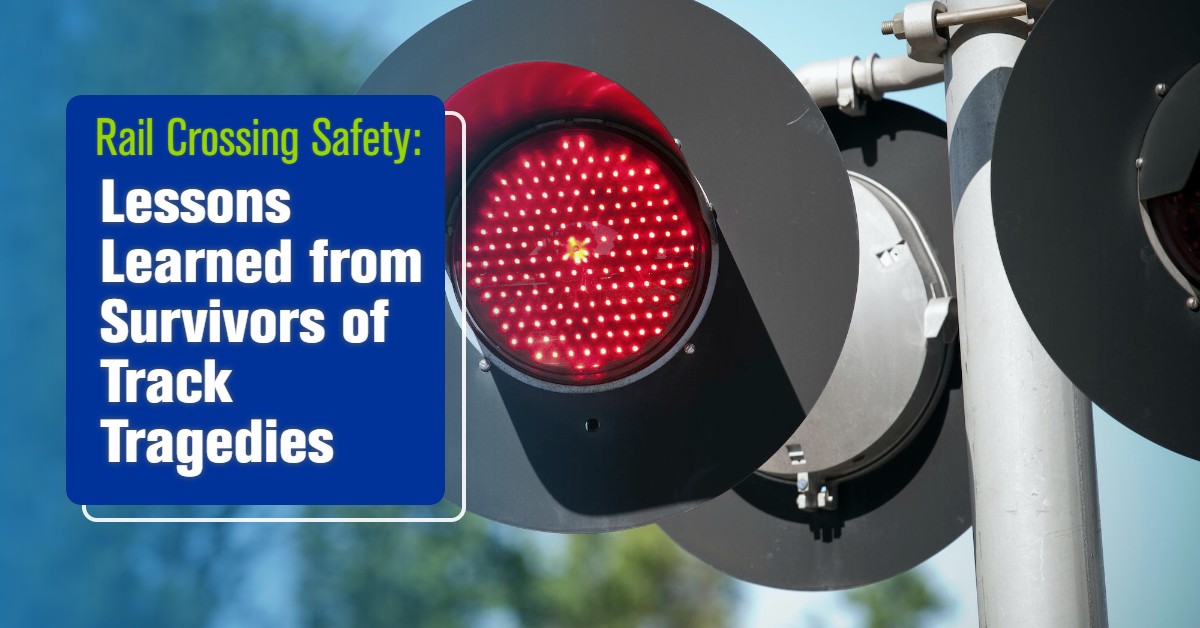Did you know:
- It takes the average freight train traveling 55 mph more than a mile—the length of 18 football fields—to stop. Trains cannot stop quickly.
- The average locomotive weighs about 400,000 pounds or 200 tons; it can weigh up to 6,000 tons.
- Trains are quieter and moving faster than you think.
These aren’t just fun facts. They are three very good reasons to take rail crossing safety seriously. If you don’t, it could cost you your life or the lives of others.
The five stories that follow are told by the survivors of track tragedies. These incidents aren’t statistics; they are events that change people’s lives forever. And they are a powerful reminder of why it’s so important to obey the rules about how to act around train tracks.
Don’t Try to Beat a Train
When the driver of a tractor trailer tried to beat an Amtrak train, it caused a catastrophic collision that took Ashley’s right leg as well as the lives of her mom, two best friends, and niece.
“Sitting at a train crossing for 10 minutes can be really annoying and could make you late to work, but thinking about the people you could impact if you choose not to wait and how it affects the rest of their lives is something to consider. […] Making that selfish decision seems harmless but affects the way someone gets ready and has to put their leg on every day because of wanting to beat something, wanting to go faster.”
- VIDEO: Hear Ashley’s story.
Wait for the Crossbucks to Clear
A 79-year-old cyclist waited at a crossing for the train to pass but didn’t wait for the safety gates to lift. What he didn’t know when he started to cross the tracks was that another train was traveling in the opposite direction. Two locomotive engineers share how that day’s events made a mark on their lives forever.
“I went back to the crossing to tend to attend to the scene. […] The gentleman was obviously a very avid cyclist. His pants were secured so they didn’t get caught in the chain. He was wearing a helmet. He was wearing a proper jacket. He was wearing safety glasses. With all of this safety gear going on…why did he skip the one safety item that cost him his life? I’d want to know why he treated that gate, that crossing light any differently than he’d treat a traffic light? Why did he treat the train tracks any different than he would a busy road?”
Think Twice Before Crossing
Like so many teenage boys, Michael spent his Friday night hanging out at a friend’s house. Walking home that evening, he made a split-second decision that would cost him his life…and take an emotional toll on his parents and the responding officer.
“My understanding from different people I’ve talked to is that he actually got his foot caught. And he got trapped at that time. And…and the train actually hit him. These are things that you don’t even have to think about. When there’s a red light, and when there’s a rail gate that’s down, everybody’s done the thinking for you. Just abide by it. Just stop, stay — let the train go by.”
- VIDEO: Hear Michael’s story.
Don’t Trespass on Tracks
Walking on railroad tracks may seem like a good shortcut, but it’s trespassing…and incredibly dangerous. Trains can’t swerve. Trains can’t stop abruptly. By the time an engineer sees a person on the tracks, it’s already too late. Maurice experienced this firsthand just a few years into his career as a locomotive engineer when the train he was driving struck a pedestrian on the tracks.
“It was over 10 years ago, and I still think about it every day.”
Always Cross at a Designated Crossing
Twenty-two-year-old Chris went out to the bar with friends. That night, he decided to be safe and leave his car at home because he knew he’d be drinking. At the end of the evening, he rode a friend’s bike home and took a shortcut across some train tracks. He didn’t cross at a designated crossing, and he slipped and fell off the bike onto the tracks. The next day his mom got a phone call from Chris’ dad saying he’d been in an accident, to which she responded, “He’s okay, right?” And then she heard the four worst words of her life: “No. Chris is dead.”
“I really miss him when there’s a family holiday. There is always that empty chair at the table and always that empty spot in my heart.”
Learn More
Don’t be — or cause — a track tragedy. Operation Lifesaver, Inc. (OLI) is a non-profit organization committed to preventing collisions, injuries and fatalities on and around railroad tracks and highway-rail grade crossings. Visit their website to get valuable resources about how to stay safe near trains and take the Rail Safety Pledge. Kids can take the pledge too.
Related Articles
- Rail Crossing Safety: Fact or Fiction?
- 11 Train Facts that Could Save Your Life
- Railroad Tech: Rail Safety, Security and Visibility Innovations
- What Can a Railroad Build?
- Railroad History: How the Rail Industry Has Evolved in 160 Years
- Rail Shipper Tips: How to Prevent Train Derailments on Privately Owned Tracks
- Railroad Safety: Train Horns and Grade Crossing Signals
- How Do Railroads Keep Cross-Border Shipments Safe?
- Transportation Modes Revealed: Rail
- Rail 101 FAQs
- 12 Train Facts You Might Not Know
- Quiz: Can Your Product Ship by Rail?









